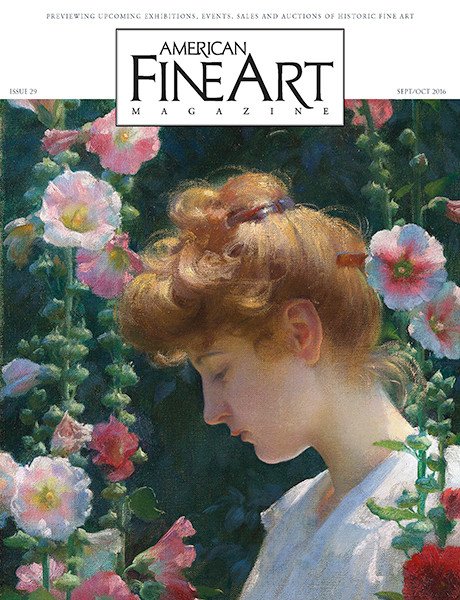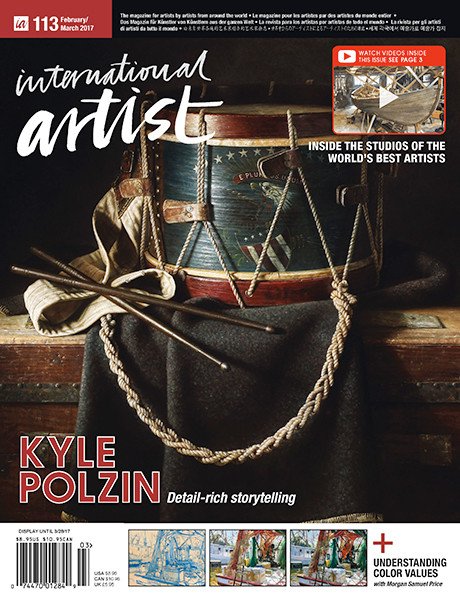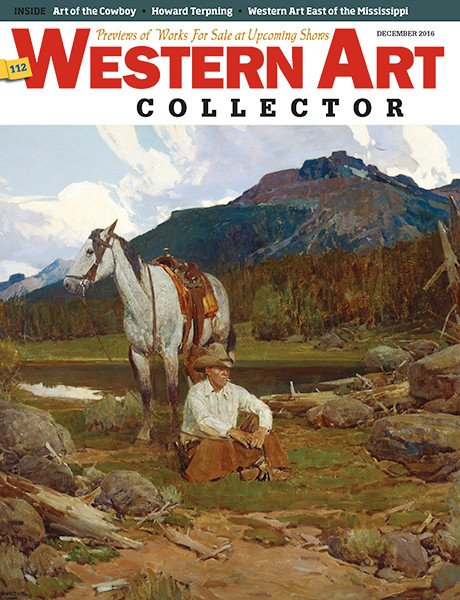Adobe Gallery
221 Canyon RoadSanta Fe, NM 87501
505-955-0550
Email this Gallery
Visit Gallery Website
Adobe Gallery
4/1/2025 - 4/30/2025
Acoma Pueblo Polychrome Jar by Santana Sanchez c.1930s
Santana Sanchez, Acoma Pueblo Potter
clay and pigments
10.5 x 11.25 inches (L x W)
Item # C4912A. The jar's intricate design reflects deeply rooted Acoma designs, featuring a striking central medallion with origins tracing back to the 1880s. This medallion consists of tiny dots enclosed within circles set inside squares, complemented by quartets of red C-shaped elements. Pueblo potters historically maintained family-based design traditions, reinforcing the idea that this medallion was possibly passed down through generations of Santana Sanchez's family. Interestingly, a similar medallion reappeared on a jar by Rachel Aragon in the early 1990s. While we do not have information that Aragon is directly related to Santana Sanchez, the presence of this medallion on her work provides a fascinating insight into how Pueblo pottery designs are passed down and reinterpreted by later generations.
https://www.adobegallery.com/art/acoma-pueblo-historic-pottery-santana-sanchez-designs

Eye-Dazzling Laguna Polychrome Jar by Evelyn Cheromiah
Evelyn Cheromiah, Laguna Pueblo Potter
clay, pigment
10 x 12 inches (L x W)
Item # C4905. This polychrome jar by Evelyn Cheromiah showcases her mastery of design and precision. The jar's overall composition is centered around eight large, eye-catching diamonds, each containing a meticulously crafted nine-part checkerboard pattern alternating between black and white. This intricate detail draws the viewer in, guiding the eye in a rhythmic journey around the jar.
https://www.adobegallery.com/art/laguna-pueblo-polychrome-pottery-evelyn-cheromiah-designs

Hopi-Tewa Migration Seed Jar by Fannie Nampeyo
Fannie Polacca Nampeyo, Hopi-Tewa Potter
Clay
4.5 x 7.5 inches (L x W)
Item # C4850P Created around 1985 by Fannie Polacca Nampeyo, this seed jar is a remarkable example of her craftsmanship. Rendered in vibrant polychrome, the jar is adorned with the traditional Sikyatki migration pattern. This pattern, originating from the ancient Sikyatki pottery of the Hopi people, symbolizes the movement and journey of the Hopi clans. It often features intricate, flowing lines and shapes that mimic the flight paths of birds, embodying themes of migration and continuity.
https://www.adobegallery.com/art/hopi-pueblo-migration-pattern-seed-jar-fannie-nampeyo

Jeddito Clay Large Seed Jar by Mark Tahbo
Mark Tahbo, Hopi-Tewa Potter
clay
5.25 x 10.75 inches (L x W)
Item # C4848ZT This beautiful seed jar was made by notable Hopi-Tewa potter Mark Tahbo. It was made in 2001, using clay from the Jeddito area of the Hopi Mesas. There is no design and no slip, only the stone-polished natural clay. The artist chose to highlight the beauty of the vessel shape and let it stand alone without potentially distracting designs.
https://www.adobegallery.com/art/jeddito-clay-large-seed-jar-by-mark-tahbo

Joy Navasie Hopi Pueblo Wedding Vase
Joy Navasie, Frog Woman
clay
13.75 x 7.75 inches (L x W)
Item # C4850ZB. Joy Navasie (Second Frog Woman)'s stunning wedding vase showcases exceptional Hopi-Tewa artistry with intricate beak and eagle tail motifs.
https://www.adobegallery.com/art/joy-navasie-frog-woman-hopi-pueblo-wedding-vase

Laguna Pueblo Black-on-cream jar with Zuni Influence
Once Known Native American Potter
clay
7.5 x 10.5 inches (L x W)
Item # C4820B
This is a historic pottery jar, a typical example of early 20th-century craftsmanship, originating from a potter at Laguna Pueblo. It was gifted to a visiting resident of the pueblo in the 1920s.
The jar features two large designs, each applied twice on opposing sides:
The first design begins with a rectangular box filled with dark brown triangles positioned up and down. These triangles are connected by a line running from the upper to the lower triangles. Attached to the rectangle's side walls are fan-like protrusions, resembling clouds, constructed with dark brown and fine lines. The second design is presented in a lighter fashion, consisting of dark brown triangles stacked vertically. Adjacent to these triangles are matching designs of spirals enclosing parallel fine lines. Double framing lines enclose the design on the upper and lower boundaries.
The lower section of the jar and the interior below the rim adhere to the traditional style of the pueblo. The jar also features a concave underbody.
https://www.adobegallery.com/art/laguna-pueblo-pottery-jar-zuni-design-influence

Large San Ildefonso Pueblo Black-on-black Pottery Jar signed Marie—Julian
Maria Martinez (1887-1980) San Ildefonso Pueblo
Clay
5.75 x 8.5 inches (L x W)
Item # 26356. The jar, bearing the dual signature Marie & Julian was likely completed in the 1930s. This period is characterized by Julian's simple and elegant designs, as exemplified by the three-pronged Avanyu design with seven small matte black dots. The jar's organic shape is visually pleasing, with a small base that expands and curves upwards, culminating in a pyramidal wall. The entire jar, except for the matte decorative elements, is polished.
https://www.adobegallery.com/art/large-san-ildefonso-pueblo-black-on-black-pottery-jar-signed-marie-julian

Large Storage Jar with Birds and Flowers by Santana Melchor and Crucita Melchor
Santana Melchor, Kewa - Santo Domingo Pueblo Potter
clay, pigment
12 x 13 inches (L x W)
Item # C4850ZM This large storage jar by Santana Melchor and Crucita Melchor features alternating bird and flower motifs. The body of the jar is painted with a cream slip. The design is painted with black pigment, with the same light brown slip used for the interior also coloring the details and the bottom of the jar. The design includes three large birds, likely turkeys as suggested by the turkey tracks on the bottom, with floral elements interspersed between them. The jar is signed by Santana Melchor and Crucita Melchor Santo Domingo.
https://www.adobegallery.com/art/large-storage-jar-with-birds-and-flowers-by-santana-melchor

San Ildefonso Historic Polychrome Pottery Water Jar
Once Known Native American Potter
Clay
9.5 x 10.5 inches (L x W)
Item # C4730.30 This polychrome olla was made by a San Ildefonso Pueblo potter. San Ildefonso Pueblo is most commonly recognized for the Black-on-black pottery that was originally created by Maria and Julian Martinez around 1920. Prior to that and dating back to about 1880, polychrome pieces like this one were the predominant style. Before 1880, the red that appears heavily on later polychrome jars was used only for thin bands at the rim and base. Not coincidentally, 1880 marked the arrival of the tourist trade—the heavy use of red likely evolved to meet the demands of the market.
https://www.adobegallery.com/art/historic-polychrome-san-ildefonso-pueblo-pottery-water-jar

San Ildefonso Large Polychrome Jar by Blue Corn
Crucita Gonzales Calabaza - Blue Corn, San Ildefonso Pueblo Pottery Matriarch
clay, pigments
9.75 x 8.75 inches (L x W)
Item # C4813B. This jar, with its shape reminiscent of Blue Corn's favored style, stands out due to its unusually large size. The design features a traditional feather pattern, with each feather vertically positioned and highlighted with a dark green block near the tip. The upper neck of the jar is adorned with a checkerboard pattern, alternating between a dark yellow pigment and the jar's base slip. This pattern is mirrored in a pair of bands located below the jar's widest area, repeating the yellow and green colors. The cream slip, a unique stone-polished concoction devised by Blue Corn and her husband, Sandy, adds a distinctive finish to the jar.
https://www.adobegallery.com/art/san-ildefonso-pueblo-polychrome-pottery-blue-corn-designs

Santa Ana Pueblo Magnificent Historic Jar c.1830
Once Known Native American Potter
clay, pigment
10 x 11.5 inches (L x W)
Item # C4815C Potters at Santa Ana Pueblo have a distinct and recognizable pottery style that has existed for the past several hundred years. Its warmth of soft dark tan slip bathed with deep red designs is unmistakable as uniquely Santa Ana Pueblo pottery. This jar, dating from 1830, is typical in shape and design of pottery of the first half of the nineteenth century and continuing into the twentieth century. The paste easily displays the standard temper of river-worn sand. Santa Ana‘s original pueblo was located near Zia Pueblo. In 1687, Santa Ana was attacked, and the village was burned. Eventually, the Santa Anas relocated their village in the eighteenth century on land bordering San Felipe Pueblo. At their village near Zia Pueblo, potters had access to lava stone to crush for use as temper for pottery. After their relocation, lava stone was no longer available, so they began using sand from the Rio Grande.
https://www.adobegallery.com/art/santa-ana-pueblo-magnificent-historic-pottery-circa-1830

Santo Domingo Pueblo Black-on-cream Aguilar Sisters OLLA
Felipita Aguilar Garcia, Asuncion Aguilar Caté, and Mrs. Ramos Aguilar, Santo Domingo Pueblo Pottery Matriarchs
clay, pigments
10.25 x 9.5 inches (L x W)
Item # C4752A. This pottery OLLA, or water jar, was made by Felipita Aguilar Garcia and Asuncion Aguilar Caté, the Kewa Pueblo potters who are commonly referred to as the Aguilar Sisters. During the late 1800s and early 1900s, the Aguilar sisters created some of the finest Kewa pottery of the era. They developed a style that was unlike anything that had been made previously, using bold black pigments and unusual polychrome designs.
https://www.adobegallery.com/art/black-on-cream-aguilar-pottery-santo-domingo-pueblo

Small Seed Jar with Corn Design by Iris Nampeyo
Iris Youvella Nampeyo
clay
2.75 x 4 inches (L x W)
Item # C4902F. Iris Youvella Nampeyo's Sikyatki seed jar features an upward-curving mouth and a matte relief corn ear contrasting with the polished natural clay.
https://www.adobegallery.com/art/hopi-pueblo-pottery-seed-jar-corn-design-iris-nampeyo-modern

Southwest Indian Pottery Acoma Pueblo, Haak’u Historic, Nineteenth Century Acoma Pueblo OLLA with Tularosa Design
Once Known Native American Potter
clay, pigment
12 x 13.5 inches (L x W)
Item # C4861A. This Acoma jar is an excellent example of the use of Tularosa patterning. The curvilinear scrolls that circumnavigate the mid body are flanked on the upper and lower extremities with rectangular and triangular stepped black-on-white designs. Throughout, these designs are very fine hatching lines that fill the previously undecorated white areas. As was the Tularosa tradition, the design elements are close together, solids are heavy, and hatching lines are very fine.
https://www.adobegallery.com/art/nineteenth-century-acoma-pueblo-pottery-tularosa-design

Southwest Indian Pottery Cochiti Pueblo, KO-TYIT Historic Cochiti Pueblo Pottery Jar c. 1880s-1900
Once Known Native American Potter
clay, pigments
9.5 x 10.5 inches (L x W)
Item # C4663B. This Cochiti Pueblo historic jar, dating from the 1880s to 1900, is a magnificent example of Cochiti Pueblo pottery. Created by a once-known Native American potter, this vessel makes a bold and commanding statement with its beautifully balanced form. It features a high shoulder and a neck slightly larger in width to the base, creating a graceful profile that flows seamlessly from the base to the delicately curled rim.
https://www.adobegallery.com/art/historic-cochiti-pueblo-pottery-jar-designs-deer

Southwest Indian Pottery Cochiti Pueblo, KO-TYIT Historic Kiua Polychrome Cochiti Variety circa 1840s Storage Jar
Once Known Native American Potter
clay, pigment
17 x 19 inches (L x W)
Item # C4794A. Pottery of this early period from Kewa (formerly Santo Domingo) and Cochiti Pueblos has traditionally been designated as Kiua Polychrome, with an origin stated as one of the two pueblos. This large storage jar has an origin of Cochiti Pueblo, so its designation is Kiua Polychrome Cochiti Variety. The jar has a red rim that continues into the neck of the jar as a rag-wiped band in the interior. There is a pair of framing lines at the neck and at the base of the bentonite-slipped decorated area. All the framing lines feature a traditional ceremonial line break. A wide black band, flanked by two thinner black bands, encircles the shoulder of the jar. Each of these three bands has a ceremonial line break. A wide red band was wiped over the un-slipped stone-polished underbody.
https://www.adobegallery.com/art/historic-kiua-polychrome-cochiti-variety-circa-1840s-storage-jar

The Legacy of the Tafoya Family
Margaret Tafoya (1904 - 2001) Santa Clara Pueblo
clay
Throughout the years, the Tafoya family has introduced several influential techniques, from Sara Fina’s pressed impression pieces and Margaret’s deep carving to contemporary adaptations of these techniques seen in Nathan Youngblood’s works. These innovators have enhanced the visual and tactile appeal of Pueblo pottery, making the Tafoya name synonymous with excellence and creativity.
https://www.adobegallery.com/shows/santa-clara-pueblo-pottery-margaret-tafoya-family

Tony Da Red Pottery Plate with Antelope Image
Tony Da (1940-2008) Thun-Phoe-She
clay
Item # C4848ZD. This brilliantly burnished dish was created by Tony Da, grandson of Maria Martinez who went on to become one of the most significant pueblo potters. Those who are familiar with Da's work will likely recognize the style of this plate, which places a sgraffito-carved figure in the center of a polished dish, with a pair of framing lines around the rim. This style is popular among today's collectors, and for good reason—these pieces are stylish, timeless, and beautiful.
https://www.adobegallery.com/art/tony-da-san-ildefonso-pueblo-red-pottery-antelope-image

Very Large Historic Ohkay Owingeh Pueblo Black over Gray Pottery Storage Jar
Once Known Native American Potter
Clay
16 x 20 inches (L x W)
Item # 26081 This large black-over-gray storage jar is from the late 19th century. It's a perfect example of Ohkay Owingeh pottery of the period. The globular shape of the vessel, the short neck, and the rough but consistent polish are standard fare for the period. Its size—16 inches in height by 20 inches in diameter—is visually impressive, but it's typical for an Ohkay Owingeh storage jar to be this large. Most importantly, the vessel is gorgeous. Its simplicity is its most striking attribute. This is a perfect example of the very finest pottery produced by this pueblo.
https://www.adobegallery.com/art/very-large-ohkay-owingeh-black-over-gray-storage-jar

Very Large Historic Polychrome Pictorial Hopi Pueblo Pottery Storage Jar
Once Known Native American Potter
clay, pigment
16.5 x 16.25 inches (L x W)
Item # 25994. When a magnificent Hopi Pueblo pottery jar surfaces, the temptation is to try to assign the name of the maker. Most often, there are clues that lead one to select a maker—clues such as vessel shape, certain design elements, and age, perhaps—but it is not always so clear cut. When this jar came to us, our first guess was that it could have been made by Daisy Hooee Nampeyo (1920-1990), daughter of Annie Healing Nampeyo and granddaughter of Nampeyo, however we now believe it dates too early to have been made by her.
https://www.adobegallery.com/art/very-large-hopi-polychrome-pictorial-storage-jar




